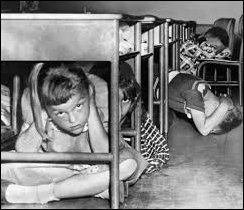
by James C. Sherlock
The federal government’s relationships with state and local governments is defined by the U.S. Constitution. Presidential management of internal national crises is constrained by lack of command authority over the states. No governor works for the President. He cannot order them to do anything, even in wartime. He can take control of industries, but not state governments. If the President nationalizes the National Guard, the Guard loses its ability to enforce state laws or respond to the Governor. And no, I don’t think we need to change our constitution.
The most complete restructuring of the federal government in my lifetime was the creation of the Department of Homeland Security after 9/11 and a complete rewrite of the National Response Plan. Giving birth to that full-grown mastodon was as noisy and bloody as you can imagine. After its birth, it was very awkward for a time. FEMA, now an element of DHS, existed at 9/11 exclusively as an agency that wrote checks upon the Presidential implementation of the Stafford Act. Although all of the plans and programs were restructured in 2002 and 2003, FEMA had that same role when Katrina happened in 2005.
After Katrina, the National Response Plan (NRP) was re-written again. The lessons learned from that tragedy resulted in a major restructuring of FEMA to support a national emergency command center and greatly improve its logistics capabilities, but those logistics capabilities still largely lie with check writing to implement contracts negotiated both before and during crises. Virtually every other major federal agency has a role in federal response coordinated by FEMA with participation of other federal agencies defined in plans specific to the type of emergency. The White House has its own staff to support the president and direct the federal agencies.
State Annexes to the NRP- and the HSS-funded Hospital Preparedness Program (HPP) are written by the states on templates provided by the federal government, and the effort to create and refine them is funded by the federal government. The federal templates ensure that state response and federal responses have the same playbook, use the same terminology and have parallel structures to enable real-time coordination. The federal government supplies the materials and funds state training and exercises. But participation by a state in those training and exercise programs is voluntary. Some do more, some do less. Some officially participate but the key leaders do not.
Over 10 years of working within this system before my retirement, it was my professional observation that states have been led to water by federal efforts and funding. Some of them drink, some don’t. Most of that pertains to training and exercises. Others are about equipment and state emergency supplies. I related my story about Louisiana Gov. Blanco’s failure to accept the Department of Defense’s offer of free emergency systems upgrades in 2004 that would have made a huge difference during Katrina. I did not mention that she was never present during the demonstrations of that technology in her Emergency operations center.
So, the fact that the President’s task force reports supply and logistics data that seem to be refuted by local reports of shortages makes perfect sense to me based on my experience with the system. Federal logistics is not a “last mile” system by design. If you think about it, the federal government really cannot be expected to perform that role in 50 states simultaneously. Under the existing system, it delivers supplies and equipment to state-designated supply centers. It is the responsibility of the state to get them to hospitals and other care providers on a prioritized basis — each state because of the federal templates has plans in place to do that. Not every state has rigorously exercised those plans pre-crisis. So, what we get is what we see happening. The President yesterday recommended that governors who are not doing so should use the National Guard to distribute federally-provided supplies and equipment. They should have been way ahead of him.
Remember, all of this in future years when you choose your Governor. Ask each candidate how they will lead the Commonwealth in an emergency and inspect their records to see if such leadership can be reasonably expected. The General Assembly will have to assert oversight of state emergency training and exercise programs with new law. I expect that Governor Northam will be eager to sign such a law.

Leave a Reply
You must be logged in to post a comment.